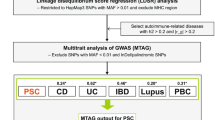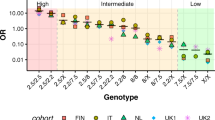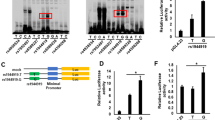Abstract
Primary sclerosing cholangitis (PSC) is a severe liver disease of unknown etiology leading to fibrotic destruction of the bile ducts and ultimately to the need for liver transplantation1,2,3. We compared 3,789 PSC cases of European ancestry to 25,079 population controls across 130,422 SNPs genotyped using the Immunochip4. We identified 12 genome-wide significant associations outside the human leukocyte antigen (HLA) complex, 9 of which were new, increasing the number of known PSC risk loci to 16. Despite comorbidity with inflammatory bowel disease (IBD) in 72% of the cases, 6 of the 12 loci showed significantly stronger association with PSC than with IBD, suggesting overlapping yet distinct genetic architectures for these two diseases. We incorporated association statistics from 7 diseases clinically occurring with PSC in the analysis and found suggestive evidence for 33 additional pleiotropic PSC risk loci. Together with network analyses, these findings add to the genetic risk map of PSC and expand on the relationship between PSC and other immune-mediated diseases.
This is a preview of subscription content, access via your institution
Access options
Subscribe to this journal
Receive 12 print issues and online access
$209.00 per year
only $17.42 per issue
Buy this article
- Purchase on Springer Link
- Instant access to full article PDF
Prices may be subject to local taxes which are calculated during checkout



Similar content being viewed by others
References
Aadland, E. et al. Primary sclerosing cholangitis: a long-term follow-up study. Scand. J. Gastroenterol. 22, 655–664 (1987).
Broomé, U. et al. Natural history and prognostic factors in 305 Swedish patients with primary sclerosing cholangitis. Gut 38, 610–615 (1996).
Farrant, J.M. et al. Natural history and prognostic variables in primary sclerosing cholangitis. Gastroenterology 100, 1710–1717 (1991).
Cortes, A. & Brown, M.A. Promise and pitfalls of the Immunochip. Arthritis Res. Ther. 13, 101 (2011).
Karlsen, T.H., Schrumpf, E. & Boberg, K.M. Update on primary sclerosing cholangitis. Dig. Liver Dis. 42, 390–400 (2010).
Karlsen, T.H. & Kaser, A. Deciphering the genetic predisposition to primary sclerosing cholangitis. Semin. Liver Dis. 31, 188–207 (2011).
Saarinen, S., Olerup, O. & Broome, U. Increased frequency of autoimmune diseases in patients with primary sclerosing cholangitis. Am. J. Gastroenterol. 95, 3195–3199 (2000).
Bergquist, A. et al. Increased risk of primary sclerosing cholangitis and ulcerative colitis in first-degree relatives of patients with primary sclerosing cholangitis. Clin. Gastroenterol. Hepatol. 6, 939–943 (2008).
Karlsen, T.H. et al. Genome-wide association analysis in primary sclerosing cholangitis. Gastroenterology 138, 1102–1111 (2010).
Srivastava, B. et al. Fine mapping and replication of genetic risk loci in primary sclerosing cholangitis. Scand. J. Gastroenterol. 47, 820–826 (2012).
Folseraas, T. et al. Extended analysis of a genome-wide association study in primary sclerosing cholangitis detects multiple novel risk loci. J. Hepatol. 57, 366–375 (2012).
Melum, E. et al. Genome-wide association analysis in primary sclerosing cholangitis identifies two non-HLA susceptibility loci. Nat. Genet. 43, 17–19 (2011).
Ellinghaus, D. et al. Genome-wide association analysis in sclerosing cholangitis and ulcerative colitis identifies risk loci at GPR35 and TCF4. Hepatology published online; 10.1002/hep.25977 (23 July 2012).
Trynka, G. et al. Dense genotyping identifies and localizes multiple common and rare variant association signals in celiac disease. Nat. Genet. 43, 1193–1201 (2011).
Pirinen, M., Donnelly, P. & Spencer, C. Efficient computation with a linear mixed model on large-scale data sets with applications to genetic studies. Ann. Appl. Stat. 7, 369–390 (2013).
Cordell, H.J. & Clayton, D.G. A unified stepwise regression procedure for evaluating the relative effects of polymorphisms within a gene using case/control or family data: application to HLA in type 1 diabetes. Am. J. Hum. Genet. 70, 124–141 (2002).
Peters, U. et al. Meta-analysis of new genome-wide association studies of colorectal cancer risk. Hum. Genet. 131, 217–234 (2012).
Gerstein, M.B. et al. Architecture of the human regulatory network derived from ENCODE data. Nature 489, 91–100 (2012).
Rossin, E.J. et al. Proteins encoded in genomic regions associated with immune-mediated disease physically interact and suggest underlying biology. PLoS Genet. 7, e1001273 (2011).
Raychaudhuri, S. et al. Identifying relationships among genomic disease regions: predicting genes at pathogenic SNP associations and rare deletions. PLoS Genet. 5, e1000534 (2009).
Hanna, R.N. et al. The transcription factor NR4A1 (Nur77) controls bone marrow differentiation and the survival of Ly6C− monocytes. Nat. Immunol. 12, 778–785 (2011).
Jostins, L. et al. Host-microbe interactions have shaped the genetic architecture of inflammatory bowel disease. Nature 491, 119–124 (2012).
Kasler, H.G. et al. Histone deacetylase 7 regulates cell survival and TCR signaling in CD4/CD8 double-positive thymocytes. J. Immunol. 186, 4782–4793 (2011).
Dequiedt, F. et al. HDAC7, a thymus-specific class II histone deacetylase, regulates Nur77 transcription and TCR-mediated apoptosis. Immunity 18, 687–698 (2003).
Dequiedt, F. et al. Phosphorylation of histone deacetylase 7 by protein kinase D mediates T cell receptor–induced Nur77 expression and apoptosis. J. Exp. Med. 201, 793–804 (2005).
Clark, K. et al. Phosphorylation of CRTC3 by the salt-inducible kinases controls the interconversion of classically activated and regulatory macrophages. Proc. Natl. Acad. Sci. USA 109, 16986–16991 (2012).
Raychaudhuri, S. et al. Five amino acids in three HLA proteins explain most of the association between MHC and seropositive rheumatoid arthritis. Nat. Genet. 44, 291–296 (2012).
Schrumpf, E. et al. HLA antigens and immunoregulatory T cells in ulcerative colitis associated with hepatobiliary disease. Scand. J. Gastroenterol. 17, 187–191 (1982).
Spurkland, A. et al. HLA class II haplotypes in primary sclerosing cholangitis patients from five European populations. Tissue Antigens 53, 459–469 (1999).
Stokkers, P.C., Reitsma, P.H., Tytgat, G.N. & van Deventer, S.J. HLA-DR and -DQ phenotypes in inflammatory bowel disease: a meta-analysis. Gut 45, 395–401 (1999).
Okada, Y. et al. HLA-Cw*1202-B*5201-DRB1*1502 haplotype increases risk for ulcerative colitis but reduces risk for Crohn's disease. Gastroenterology 141, 864–871.e1–5 (2011).
Horton, R. et al. Gene map of the extended human MHC. Nat. Rev. Genet. 5, 889–899 (2004).
Hov, J.R. et al. Electrostatic modifications of the human leukocyte antigen–DR P9 peptide–binding pocket and susceptibility to primary sclerosing cholangitis. Hepatology 53, 1967–1976 (2011).
Hovhannisyan, Z. et al. The role of HLA-DQ8 β57 polymorphism in the anti-gluten T-cell response in coeliac disease. Nature 456, 534–538 (2008).
Broomé, U. & Bergquist, A. Primary sclerosing cholangitis, inflammatory bowel disease, and colon cancer. Semin. Liver Dis. 26, 31–41 (2006).
CARDIoGRAMplusC4D Consortium. Large-scale association analysis identifies new risk loci for coronary artery disease. Nat. Genet. 45, 25–33 (2013).
Zhernakova, A., van Diemen, C.C. & Wijmenga, C. Detecting shared pathogenesis from the shared genetics of immune-related diseases. Nat. Rev. Genet. 10, 43–55 (2009).
Benjamini, Y. & Hochberg, Y. Controlling the false discovery rate: a practical and powerful approach to multiple testing. J. R. Stat. Soc. B 57, 289–300 (1995).
Storey, J.D. The positive false discovery rate: a Bayesian interpretation and the q-value. Ann. Stat. 31, 2013–2035 (2003).
Efron, B. Simultaneous inference: when should hypothesis testing problems be combined? Ann. Appl. Statist. 2, 197–223 (2008).
Sun, L., Craiu, R.V., Paterson, A.D. & Bull, S.B. Stratified false discovery control for large-scale hypothesis testing with application to genome-wide association studies. Genet. Epidemiol. 30, 519–530 (2006).
Purcell, S. et al. PLINK: a tool set for whole-genome association and population-based linkage analyses. Am. J. Hum. Genet. 81, 559–575 (2007).
Bellenguez, C., Strange, A., Freeman, C., Donnelly, P. & Spencer, C.C. A robust clustering algorithm for identifying problematic samples in genome-wide association studies. Bioinformatics 28, 134–135 (2012).
Patterson, N., Price, A.L. & Reich, D. Population structure and eigenanalysis. PLoS Genet. 2, e190 (2006).
1000 Genomes Project Consortium. A map of human genome variation from population-scale sequencing. Nature 467, 1061–1073 (2010).
Liu, J.Z. et al. Dense fine-mapping study identifies new susceptibility loci for primary biliary cirrhosis. Nat. Genet. 44, 1137–1141 (2012).
Howie, B.N., Donnelly, P. & Marchini, J. A flexible and accurate genotype imputation method for the next generation of genome-wide association studies. PLoS Genet. 5, e1000529 (2009).
Sawcer, S. et al. Genetic risk and a primary role for cell-mediated immune mechanisms in multiple sclerosis. Nature 476, 214–219 (2011).
Korte, A. et al. A mixed-model approach for genome-wide association studies of correlated traits in structured populations. Nat. Genet. 44, 1066–1071 (2012).
Tsoi, L.C. et al. Identification of 15 new psoriasis susceptibility loci highlights the role of innate immunity. Nat. Genet. 44, 1341–1348 (2012).
Morris, J.A., Randall, J.C., Maller, J.B. & Barrett, J.C. Evoker: a visualization tool for genotype intensity data. Bioinformatics 26, 1786–1787 (2010).
DeLong, E.R., DeLong, D.M. & Clarke-Pearson, D.L. Comparing the areas under two or more correlated receiver operating characteristic curves: a nonparametric approach. Biometrics 44, 837–845 (1988).
Schlicker, A., Domingues, F.S., Rahnenfuhrer, J. & Lengauer, T. A new measure for functional similarity of gene products based on Gene Ontology. BMC Bioinformatics 7, 302 (2006).
Schlicker, A. & Albrecht, M. FunSimMat update: new features for exploring functional similarity. Nucleic Acids Res. 38, D244–D248 (2010).
Shannon, P. et al. Cytoscape: a software environment for integrated models of biomolecular interaction networks. Genome Res. 13, 2498–2504 (2003).
Efron, B. Size, power and false discovery rates. Ann. Stat. 35, 1351–1377 (2007).
Yoo, Y.J., Pinnaduwage, D., Waggott, D., Bull, S.B. & Sun, L. Genome-wide association analyses of North American Rheumatoid Arthritis Consortium and Framingham Heart Study data utilizing genome-wide linkage results. BMC Proc. 3 (suppl. 7), S103 (2009).
So, H.C., Gui, A.H., Cherny, S.S. & Sham, P.C. Evaluating the heritability explained by known susceptibility variants: a survey of ten complex diseases. Genet. Epidemiol. 35, 310–317 (2011).
Acknowledgements
We thank all individuals with PSC and healthy controls for their participation, and we are indebted to all physicians and nursing staff who recruited subjects. We thank T. Wesse, T. Henke, S. Sedghpour Sabet, R. Vogler, G. Jacobs, I. Urbach, W. Albrecht, V. Pelkonen, V. Barbu, K. Holm, H. Dahlen Sollid, B. Woldseth, J.A. Anmarkrud and L.W. Torbjørnsen for expert help. U. Beuers, F. Braun, W. Kreisel, T. Berg and R. Günther are acknowledged for contributing German individuals with PSC. B.A. Lie and The Norwegian Bone Marrow Donor Registry at Oslo University Hospital, Rikshospitalet (Oslo, Norway) and the Nord-Trøndelag Health Study (HUNT) are acknowledged for sharing healthy Norwegian controls. Banco Nacional de ADN (Salamanca, Spain) is acknowledged for providing Spanish control samples. This study makes use of genotyping data generated by the Dietary, Life style and Genetic determinants of Obesity and Metabolic syndrome (DILGOM) consortium (see URLs), the Cooperative Research in the Region of Augsburg (KORA) study and the Heinz Nixdorf Recall (Risk Factors, Evaluation of Coronary Calcification, and Lifestyle) study. We acknowledge the members of the International PSC Study Group, the National Institute of Diabetes and Digestive and Kidney Diseases (NIDDK) Inflammatory Bowel Disease Genetics Consortium (IBDGC), the UK-PSC Consortium and the Alberta IBD Consortium for their participation. J. Barrett is acknowledged for contributions to the design of the Immunochip experiment. Individuals who have shared summary statistics and statistical software are acknowledged in the Supplementary Note.
The study was supported by The Norwegian PSC Research Center (see URLs), by the German Ministry of Education and Research through the National Genome Research Network (01GS0809-GP7), by the Deutsche Forschungsgemeinschaft (FR 2821/2-1), by the EU Seventh Framework Programme FP7/2007-2013 (262055) ESGI, by the Integrated Research and Treatment Center–Transplantation (01EO0802) and by the PopGen Biobank (see URLs). J.Z.L., T.S. and C.A.A. are supported by a grant from the Wellcome Trust (098051). Additional financial support of the study and the coauthors is listed in the Supplementary Note.
Author information
Authors and Affiliations
Consortia
Contributions
J.Z.L., J.R.H., T.F., E.E., N.T.D., I.T., G.M., I.R.K., O.A.A., W.K.T., A.M.D., T.S. and C.A.A. performed data and statistical analyses. A. Franke, C.A.A. and T.H.K. coordinated the project and supervised the data analysis. J.Z.L., J.R.H., T.F., E.E., A. Franke, C.A.A. and T.H.K. drafted the manuscript. S.M.R., R.K.W., T.J.W., B.E., P.I., G.M.H., D.N.G., A.P., D.E., B.D.J., P.M., C.R., C.S., T.M., B.S., G.D., M.M.N., S.H., J.W., M.M., F.B., C.Y.P., P.J.P.C., M. Sterneck, A.T., A.L.M., J.S., V.L., R.D., D.A., A. Floreani, S.O.-G., S.S.R., A.J.S., S.N., K.H., I.C., J.G.-A., I.R.-P., D.v.H., E.B., R.N.S., P.R.D., E.M., M.H.V., M.S.S., R.H.D., L.P., S.B., M. Sans, V.A., J.-P.A., K.M.B., H.-U.M., O.C., C.L.B., C.W., E.S., S.V., M.A., J.D.R., G.A., A.B., J.C., S.S., M.P.M., M.F., R.W.C., K.N.L., The UK-PSC Consortium, The International IBD Consortium and The International PSC Study Group contributed to the ascertainment of affected individuals and/or sample and clinical data collection. All authors revised the manuscript for critical content and approved the final version.
Corresponding authors
Ethics declarations
Competing interests
The authors declare no competing financial interests.
Additional information
Further details appear in the Supplementary Note.
Further details appear in the Supplementary Note.
Further details appear in the Supplementary Note.
Supplementary information
Supplementary Text and Figures
Supplementary Figures 1–16, Supplementary Tables 1–7, 10, 11, 16 and 17, Supplementary Note (PDF 8843 kb)
Supplementary Table 8
Association analysis for the classical HLA class I genes (Separate Excel file). (XLSX 94 kb)
Supplementary Table 9
Association analysis for the classical HLA class II genes. (Separate Excel file). (XLSX 91 kb)
Supplementary Table 12
Genes closest to the PSC and IBD lead SNPs considered for inclusion in the PSC&IBD functional similarity network shown in Supplemetary Figure 9 (Separate Excel file). (XLSX 56 kb)
Supplementary Table 13
Lead SNPs in 33 pleiotropic loci with false discovery rate(FDR)<0.001 given associations in at least one of seven diseases associated with PSC (Separate Excel file). (XLSX 179 kb)
Supplementary Table 14
Lead SNPs in 89 pleiotropic loci with 0.01<false discovery rate(FDR)<0.001 given associations in at least one of seven diseases associated with PSC (Separate Excel file). (XLSX 60 kb)
Supplementary Table 15
Genes within 0.1 cM of all PSC SNPs considered for inclusion in the PSC functional similarity network shown in Supplementary Figure 13(Separate Excel file). (XLSX 55 kb)
Rights and permissions
About this article
Cite this article
Liu, J., Hov, J., Folseraas, T. et al. Dense genotyping of immune-related disease regions identifies nine new risk loci for primary sclerosing cholangitis. Nat Genet 45, 670–675 (2013). https://doi.org/10.1038/ng.2616
Received:
Accepted:
Published:
Issue Date:
DOI: https://doi.org/10.1038/ng.2616
This article is cited by
-
Proteome-wide Mendelian randomization highlights AIF1 and HLA-DQA2 as targets for primary sclerosing cholangitis
Hepatology International (2024)
-
Biological basis of extensive pleiotropy between blood traits and cancer risk
Genome Medicine (2024)
-
ANXA1 is identified as a key gene associated with high risk and T cell infiltration in primary sclerosing cholangitis
Human Genomics (2023)
-
The genetic architecture of human amygdala volumes and their overlap with common brain disorders
Translational Psychiatry (2023)
-
Primary sclerosing cholangitis (PSC) and inflammatory bowel disease (IBD): a condition exemplifying the crosstalk of the gut–liver axis
Experimental & Molecular Medicine (2023)



